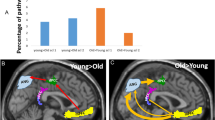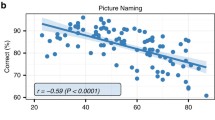Abstract
Activity attributed to the default-mode occurs during the resting state and is thought to represent self-referential and other intrinsic processes. Although activity in default-associated regions changes across the lifespan, little is known about the stability of default-mode activity in the healthy aging brain. We investigated changes in rest-specific activity across an 8 year period in older participants in the Baltimore Longitudinal Study of Aging (BLSA) neuroimaging study. Comparison of resting-state and recognition memory PET regional cerebral blood flow conditions from baseline and 8-year follow-up shows relative stability of rest-specific activity over time in medial frontal/anterior cingulate, hippocampal and posterior cingulate regions commonly associated with the default-mode. In contrast, prefrontal, parahippocampal and occipital cortical regions, which are not typically associated with default-mode activity, show changes over time. Overall, activity in the major components of the default-mode network remains stable in healthy older individuals, a finding which may assist in identifying factors that discriminate between normal and pathological aging.



Similar content being viewed by others
References
Andreasen, N. C., O'Leary, D. S., Cizadlo, T., Arndt, S., Rezai, K., Watkins, G. L., et al. (1995). Remembering the past: two facets of episodic memory explored with positron emission tomography. The American Journal of Psychiatry, 152(11), 1576–1585.
Andrews-Hanna, J. R., Snyder, A. Z., Vincent, J. L., Lustig, C., Head, D., Raichle, M. E., et al. (2007). Disruption of large-scale brain systems in advanced aging. Neuron, 56(5), 924–935. doi:10.1016/j.neuron.2007.10.038.
Beason-Held, L., Kraut, M. A., & Resnick, S. M. (2008a). I. Longitudinal changes in aging brain function. Neurobiol Aging, 29(4), 483–496. 2006 Dec, Epub ahead of print.
Beason-Held, L., Kraut, M. A., & Resnick, S. M. (2008b). II. Temporal patterns of longitudinal change in aging brain function. Neurobiol Aging, 29(4), 497–513. 2006 Dec, Epub ahead of print.
Buckner, R. L., & Vincent, J. L. (2007). Unrest at rest: default activity and spontaneous network correlations. NeuroImage, 37(4), 1091–1096. discussion 1097–1099. doi:10.1016/j.neuroimage.2007.01.010.
Cabeza, R., Anderson, N. D., Locantore, J. K., & McIntosh, A. R. (2002). Aging gracefully: compensatory brain activity in high-performing older adults. NeuroImage, 17(3), 1394–1402. doi:10.1006/nimg.2002.1280.
Damoiseaux, J. S., Rombouts, S. A., Barkhof, F., Scheltens, P., Stam, C. J., Smith, S. M., et al. (2006). Consistent resting-state networks across healthy subjects. Proceedings of the National Academy of Sciences of the United States of America, 103(37), 13848–13853. doi:10.1073/pnas.0601417103.
Damoiseaux, J. S., Beckmann, C. F., Arigita, E. J., Barkhof, F., Scheltens, P., Stam, C.J., et al. (2007). Reduced resting-state brain activity in the "default network" in normal aging. Cereb Cortex.
De Santi, S., de Leon, M. J., Rusinek, H., Convit, A., Tarshish, C. Y., Roche, A., et al. (2001). Hippocampal formation glucose metabolism and volume losses in MCI and AD. Neurobiology of Aging, 22(4), 529–539. doi:10.1016/S0197-4580(01)00230-5.
Esposito, F., Bertolino, A., Scarabino, T., Latorre, V., Blasi, G., Popolizio, T., et al. (2006). Independent component model of the default-mode brain function: assessing the impact of active thinking. Brain Research Bulletin, 70(4–6), 263–269. doi:10.1016/j.brainresbull.2006.06.012.
Grady, C. L., & Craik, F. I. (2000). Changes in memory processing with age. Current Opinion in Neurobiology, 10(2), 224–231. doi:10.1016/S0959-4388(00)00073-8.
Grady, C. L., Springer, M. V., Hongwanishkul, D., McIntosh, A. R., & Winocur, G. (2006). Age-related changes in brain activity across the adult lifespan. Journal of Cognitive Neuroscience, 18(2), 227–241. doi:10.1162/jocn.2006.18.2.227.
Greicius, M. D., & Menon, V. (2004). Default-mode activity during a passive sensory task: uncoupled from deactivation but impacting activation. Journal of Cognitive Neuroscience, 16(9), 1484–1492. doi:10.1162/0898929042568532.
Greicius, M. D., Srivastava, G., Reiss, A. L., & Menon, V. (2004). Default-mode network activity distinguishes Alzheimer's disease from healthy aging: evidence from functional MRI. Proceedings of the National Academy of Sciences of the United States of America, 101(13), 4637–4642. doi:10.1073/pnas.0308627101.
Gusnard, D. A., Akbudak, E., Shulman, G. L., & Raichle, M. E. (2001). Medial prefrontal cortex and self-referential mental activity: relation to a default mode of brain function. Proceedings of the National Academy of Sciences of the United States of America, 98(7), 4259–4264. doi:10.1073/pnas.071043098.
Herholz, K., Salmon, E., Perani, D., Baron, J. C., Holthoff, V., Frolich, L., et al. (2002). Discrimination between Alzheimer dementia and controls by automated analysis of multicenter FDG PET. NeuroImage, 17(1), 302–316. doi:10.1006/nimg.2002.1208.
Kawas, C., Gray, S., Brookmeyer, R., Fozard, J., & Zonderman, A. (2000). Age-specific incidence rates of Alzheimer's disease: the Baltimore Longitudinal Study of Aging. Neurology, 54(11), 2072–2077.
Kogure, D., Matsuda, H., Ohnishi, T., Asada, T., Uno, M., Kunihiro, T., et al. (2000). Longitudinal evaluation of early Alzheimer's disease using brain perfusion SPECT. Journal of Nuclear Medicine, 41(7), 1155–1162.
Lustig, C., Snyder, A. Z., Bhakta, M., O'Brien, K. C., McAvoy, M., Raichle, M. E., et al. (2003). Functional deactivations: change with age and dementia of the Alzheimer type. Proceedings of the National Academy of Sciences of the United States of America, 100(24), 14504–14509. doi:10.1073/pnas.2235925100.
Mazoyer, B., Zago, L., Mellet, E., Bricogne, S., Etard, O., Houde, O., et al. (2001). Cortical networks for working memory and executive functions sustain the conscious resting state in man. Brain Research Bulletin, 54(3), 287–298. doi:10.1016/S0361-9230(00)00437-8.
Minoshima, S., Giordani, B., Berent, S., Frey, K. A., Foster, N. L., & Kuhl, D. E. (1997). Metabolic reduction in the posterior cingulate cortex in very early Alzheimer's disease. Annals of Neurology, 42(1), 85–94. doi:10.1002/ana.410420114.
Park, D., Polk, T., Mikels, J., Taylor, S., & Marshuetz, C. (2001). Cerebral aging: integration of brain and behavioral models of cognitive function. Dialogues in Clinical Neuroscience, 3, 151–166.
Persson, J., Lustig, C., Nelson, J. K., & Reuter-Lorenz, P. A. (2007). Age differences in deactivation: a link to cognitive control? Journal of Cognitive Neuroscience, 19(6), 1021–1032. doi:10.1162/jocn.2007.19.6.1021.
Raichle, M. E., & Snyder, A. Z. (2007). A default mode of brain function: a brief history of an evolving idea. NeuroImage, 37(4), 1083–1090. discussion 1097–1089. doi:10.1016/j.neuroimage.2007.02.041.
Raichle, M. E., MacLeod, A. M., Snyder, A. Z., Powers, W. J., Gusnard, D. A., & Shulman, G. L. (2001). A default mode of brain function. Proceedings of the National Academy of Sciences of the United States of America, 98(2), 676–682. doi:10.1073/pnas.98.2.676.
Raz, N. (2005). The aging brain observed in vivo: differential changes and their modifiers. In R. Cabeza, L. Nyberg, & D. C. Park (Eds.), Cognitive Neuroscience of Aging: Linking Cognitive and Cerebral Aging (pp. 19–57). New York: Oxford University Press.
Resnick, S., Pham, D., Kraut, M., Zonderman, A., & Davatzikos, C. (2003). Longitudinal magnetic resonance imaging studies of older adults: a shrinking brain. The Journal of Neuroscience, 23(8), 3295–3301.
Resnick, S. M., Goldszal, A. F., Davatzikos, C., Golski, S., Kraut, M. A., Metter, E. J., et al. (2000). One-year age changes in MRI brain volumes in older adults. Cerebral Cortex (New York, N.Y.), 10(5), 464–472. doi:10.1093/cercor/10.5.464.
Reuter-Lorenz, P., Marshuetz, C., Jonides, J., Smith, E., Hartley, A., & Koeppe, R. (2001). Neurocognitive ageing of storage and executive processes. The European Journal of Cognitive Psychology, 13(1-2), 257–278. doi:10.1080/09541440125972.
Rombouts, S. A., Barkhof, F., Goekoop, R., Stam, C. J., & Scheltens, P. (2005). Altered resting state networks in mild cognitive impairment and mild Alzheimer's disease: an fMRI study. Human Brain Mapping, 26(4), 231–239. doi:10.1002/hbm.20160.
Shen, D., & Davatzikos, C. (2002). HAMMER: hierarchical attribute matching mechanism for elastic registration. IEEE Transactions on Medical Imaging, 21(11), 1421–1439. doi:10.1109/TMI.2002.803111.
Shulman, G., Fiez, J., Corbetta, M., Buckner, R., Miezin, F., Raichle, M., et al. (1997). Common blood flow changes across visual tasks: II. decreases in cerebral cortex. Journal of Cognitive Neuroscience, 9(5), 648–663. doi:10.1162/jocn.1997.9.5.648.
Acknowledgements
This research was supported in part by the Intramural Research Program of the NIH, National Institute on Aging and by Research and Development Contract N01-AG-3-2124. We are grateful to the BLSA participants and neuroimaging staff for their dedication to these studies and the staff of the Johns Hopkins PET facility for their assistance.
Author information
Authors and Affiliations
Corresponding author
Rights and permissions
About this article
Cite this article
Beason-Held, L.L., Kraut, M.A. & Resnick, S.M. Stability of Default-Mode Network Activity in the Aging Brain. Brain Imaging and Behavior 3, 123–131 (2009). https://doi.org/10.1007/s11682-008-9054-z
Received:
Accepted:
Published:
Issue Date:
DOI: https://doi.org/10.1007/s11682-008-9054-z




